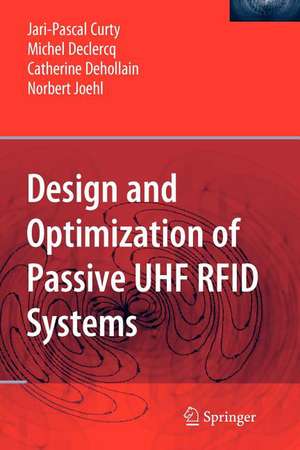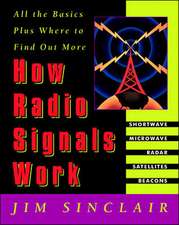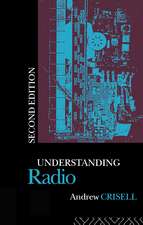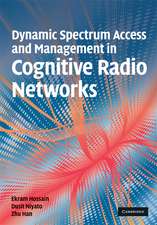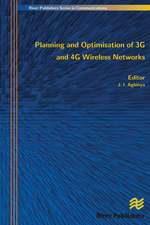Design and Optimization of Passive UHF RFID Systems
Autor Jari-Pascal Curty, Michel Declercq, Catherine Dehollain, Norbert Joehlen Limba Engleză Paperback – 29 oct 2010
or incorporated into a product, animal or person. An RFID tag contains an antenna to enable it to receive and respond to Radio-Frequency (RF) queries from an RFID reader or interrogator. Passive tags require no internal power source, whereas active tags require a power source.
As of today (2006), the concepts of ubiquitous computing and ambient intelligence are becoming widespread. In order for these to become a reality, a number of key technologies are required. In brief, these technologies need to be sensitive, responsive, interconnected, contextualised, transparent and intelligent. RFID, and in particular passive RFID tags, are such a technology. In order to deliver the necessary characteristics that could lead to ambient intelligence, however, there are some challenges that need to be addressed.
Remote powering of the tags is probably the most important challenge. Issues concerning the antenna-tag interface and the rectifier design, that allow the RF signal to be converted to Direct Current (DC) are top priorities. Secondly, the communication link and the reader should be optimized. The RF signal that contains the tag data suffers from a power of four decay with the distance between tag and reader. As a result, both the reader sensitivity and the tag backscattered power efficiency have to be maximized. Long-range powering, as well as sufficient communication quality, are the guidelines of this work.
This work proposes a linear two-port model for an N-stage modified-Greinacher full wave rectifier. It predicts the overall conversion efficiency at low power levels where the diodes are operating near their threshold voltage. The output electrical behavior of the rectifier is calculated as a function of the received power and the antenna parameters. Moreover, the two-port parameter values are computed for particular input voltages and output currents for the complete N-stage rectifier circuit, using only the measured I-V and C-V characteristics of a single diode.
Also presented in this work is an experimental procedure to measure how the impedance modulation at the tag side affects the signal at the reader. The method allows the tag designer to efficiently predict the effect of a modulator design at the system level and gives a useful instrument to choose the most appropriate impedances.
Finally, the design of a fully-integrated, remotely powered and addressable RFID tag working at 2.45GHz is described. The achieved operating range at a 4W Effective Isotropically Radiated Power (EIRP) reader transmit power is at most 12 m. The Integrated Circuit (IC) is implemented in a 0.5 um silicon-on-sapphire technology. A state-of-the-art rectifier design is embedded to supply energy to the transponder. Inductive matching and a folded-dipole antenna are key elements for achieving this performance.
| Toate formatele și edițiile | Preț | Express |
|---|---|---|
| Paperback (1) | 633.68 lei 43-57 zile | |
| Springer Us – 29 oct 2010 | 633.68 lei 43-57 zile | |
| Hardback (1) | 639.25 lei 43-57 zile | |
| Springer Us – 25 oct 2006 | 639.25 lei 43-57 zile |
Preț: 633.68 lei
Preț vechi: 745.50 lei
-15% Nou
Puncte Express: 951
Preț estimativ în valută:
121.26€ • 126.92$ • 100.92£
121.26€ • 126.92$ • 100.92£
Carte tipărită la comandă
Livrare economică 31 martie-14 aprilie
Preluare comenzi: 021 569.72.76
Specificații
ISBN-13: 9781441941992
ISBN-10: 1441941991
Pagini: 160
Ilustrații: X, 148 p.
Dimensiuni: 155 x 235 x 8 mm
Greutate: 0.23 kg
Ediția:Softcover reprint of hardcover 1st ed. 2007
Editura: Springer Us
Colecția Springer
Locul publicării:New York, NY, United States
ISBN-10: 1441941991
Pagini: 160
Ilustrații: X, 148 p.
Dimensiuni: 155 x 235 x 8 mm
Greutate: 0.23 kg
Ediția:Softcover reprint of hardcover 1st ed. 2007
Editura: Springer Us
Colecția Springer
Locul publicării:New York, NY, United States
Public țintă
ResearchCuprins
Wireless Power Transmission.- Analysis of the Modified-Greinacher Rectifier.- to RFID.- Backscattering architecture and choice of modulation type.- Backscattering modulation analysis.- RFID Tag design.- High frequency interrogator architecture and analysis.- Conclusion.
Recenzii
From the reviews:
"In this agile book of just 148 pages, the reader is introduced to the design of a passive RFID system operating in the UHF band. … The book is a useful tool for the RFID UHF system designer, and can also be a valuable guide for the newcomer interested in understanding the multifaceted issues involved in the development of RFID and of its specifications." (S. Donati and T. Tambosso, Optics and Photonics News, July/August, 2007)
"In this agile book of just 148 pages, the reader is introduced to the design of a passive RFID system operating in the UHF band. … The book is a useful tool for the RFID UHF system designer, and can also be a valuable guide for the newcomer interested in understanding the multifaceted issues involved in the development of RFID and of its specifications." (S. Donati and T. Tambosso, Optics and Photonics News, July/August, 2007)
Textul de pe ultima copertă
Radio Frequency Identification (RFID) is an automatic identification method, relying on storing and remotely retrieving data using devices called RFID tags or transponders. An RFID tag is an object that can be attached to or incorporated into a product, animal, or person for the purpose of identification using radio waves. Chip-based RFID tags contain silicon chips and antennas. Active tags require an internal power source, while passive tags do not.
Design and Optimization of UHF RFID Systems considers the analysis, design and optimization of UHF passive RFID systems for long-range applications. There are many key aspects thoroughly described in the text:
Design and Optimization of UHF RFID Systems considers the analysis, design and optimization of UHF passive RFID systems for long-range applications. There are many key aspects thoroughly described in the text:
- Wireless power transmission
- Tag-to-reader backscattering communication
- Reader and tag architectures and IC design.
Caracteristici
Proposes a linear two-port model for an N-stage modified-Greinacher full wave rectifier Two-port parameters values are computed for particular input voltages and output currents for the complete N-stage rectifier circuit using only the measured I-V and C-V characteristics of a single diode Presents an experimental procedure to measure how the impedance modulation at the tag side affects the signal at the reader Describes the design of a fully integrated remotely powered and addressable RFID tag working at 2.45 GHz Includes supplementary material: sn.pub/extras
